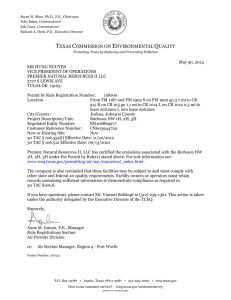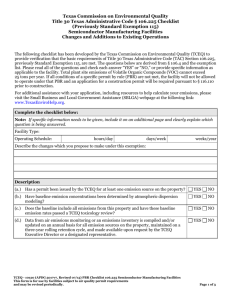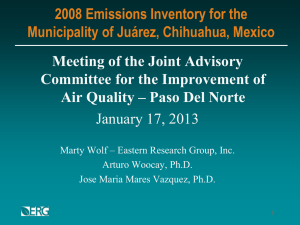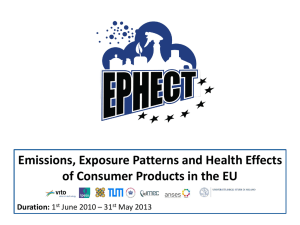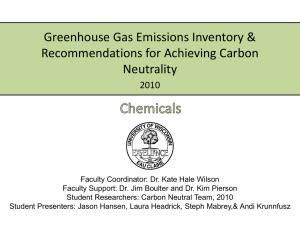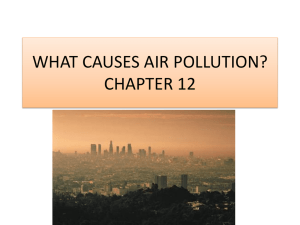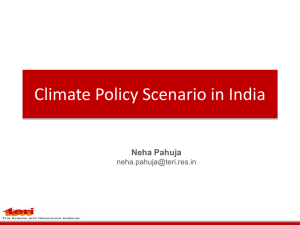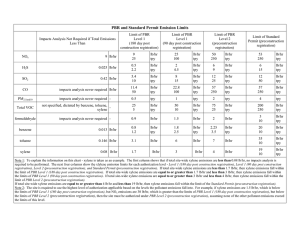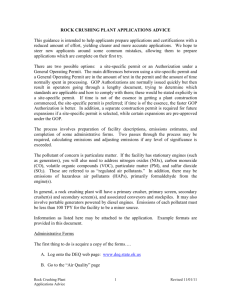2EIoverviewPart1
advertisement
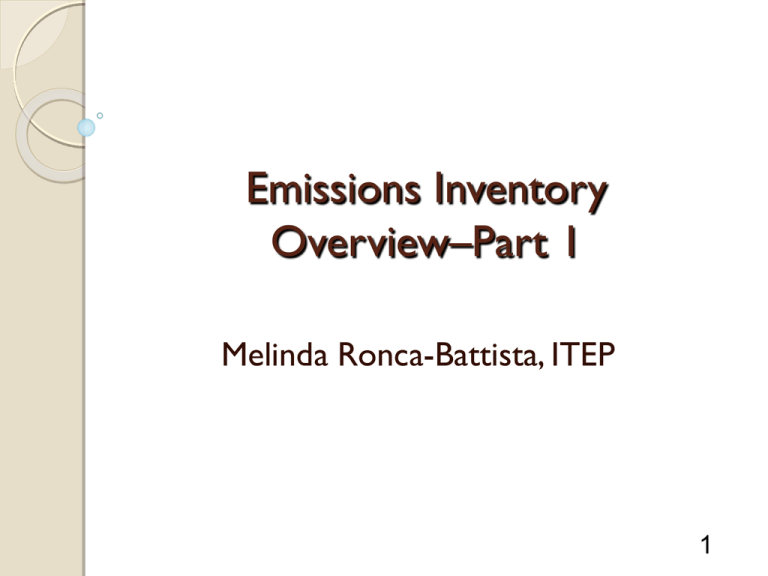
Emissions Inventory Overview–Part 1 Melinda Ronca-Battista, ITEP 1 Overview What is an Emissions Inventory and why do we need one? Part 1 ◦ Types of EIs ◦ Pollutants ◦ Sources Part 2 ◦ Quantifying emissions ◦ Types of data collected ◦ Reporting 2 What is an Emissions Inventory? Listing of sources of estimated air pollutant emissions in geographic area during specific time period 3 What are Emission Sources? Non-Point Sources (Area Sources) Non-Road Mobile Sources Point Sources On-Road Mobile Sources 4 Based on EPA How are EI data used? Air quality management tool ◦ Collect baseline data ◦ Develop & track emissions control and management strategies Regulations development Air quality modeling and assessment Permits ◦ Do you have facilities that need permits? ◦ Conditions (potential to emit) ◦ Fees Emissions trading Regulatory compliance 5 Inventory Steps Source identification ◦ Phonebook/windshield survey ◦ NEI data, previous EIs Planning! ◦ Inventory Preparation Plan (IPP) ◦ Quality Assurance Project Plan (QAPP) Collect data ◦ From sources, permits, questionnaires, etc. 6 Inventory Steps (cont.) Calculate and analyze data (TEISS, Excel, GIS, etc.) Report data and present results ◦ Internal: tribal council, community ◦ External: EPA project officer, National Emissions Inventory (NEI) 7 Level of Detail Simple summary: Small reservation, few on-reservation sources ◦ Compiled from existing data sources ◦ Includes only large sources Comprehensive accounting: Large reservation, many and/or large sources ◦ Large on-reservation sources–permitting ◦ “Problem” emissions (agricultural burning, small industries, road dust, traffic emissions) 8 What are Emissions? Criteria Pollutants ◦ ◦ ◦ ◦ ◦ Particle matter: PM10 and PM2.5 Nitrogen oxides: NOx Sulfur dioxide: SO2 Carbon monoxide: CO Lead: Pb Ozone precursors ◦ Ammonia: NH3 ◦ Volatile Organic Compounds: VOCs HAPs (Air Toxics) ◦ 187 toxic, carcinogenic compounds without regulated standards 9 Criteria Pollutants What about Ozone? ◦ Ozone is not emitted directly by sources ◦ EIs inventory ozone precursors VOCs NOx Both react with sunlight to form ozone. ◦ NOx and VOCs get inventoried, but not ozone itself 10 HAPs (Air Toxics) 187 compounds listed in CAA including ◦ ◦ ◦ ◦ ◦ Mercury (power plants, coal-fired) Perchloroethylene (dry cleaning) Benzene (gasoline) Chloroform (chlorination plants, paper mills) Methyl Isocyanate (pesticide manufacturing) Release at Bhopal, India, killed 4,000 people ◦ The list goes on…. 11 Types of Sources Point sources = Stationary sources Area sources = Non-Point sources Mobile sources ◦ On-Road (cars, motorcycles, trucks, buses) ◦ Non-Road (trains, heavy equip.) Biogenic sources 12 What is a Point Source? Individual, stationary source releasing pollutants to atmosphere Quantities above emission threshold Emission thresholds vary according to type of pollutant and non-attainment area classification for criteria pollutants See Air Emission Reporting Requirement (AERR) for more detail 13 What is a Point Source? (cont.) AERR reporting thresholds are quite high. Compared to Potential to Emit. Many states have lower thresholds Consider using state thresholds to define your reservation’s point sources ◦ Makes EI compatible with others in your area ◦ Get a more detailed listing of sources Example: Busy gas station can be point source under state thresholds, but not EPA’s 14 Example: Point Source Thresholds Pollutant Lead (Pb) PM10 PM2.5 Nitrogen Oxides (NOx) Carbon Monoxide (CO) Volatile Organic Compounds (VOC) EPA’s AERR Reporting Thresholds ≥5 ton per year (tpy) ≥100 tpy New Mexico Reporting Thresholds >1 ton per year (tpy) >10 tpy ≥100 tpy ≥100 tpy >10 tpy >10 tpy ≥1000 tpy >10 tpy ≥100 tpy >10 tpy 15 Point Source Characteristics Large, stationary sources ◦ Manufacturing or production plants ◦ Power plants, refineries ◦ Large, industrial facilities One point source facility can have emissions from ◦ Smoke stacks ◦ Units within directed to stacks ◦ Fugitive sources within plant 16 Point Sources (cont.) 17 Area (Non-Point) Sources Stationary sources that emit ◦ Less than point source threshold ◦ Smaller emitters, but numerous ◦ Often have fugitive (uncontrollable) emissions Tend to be sources like Gasoline stations Dry cleaners Auto body/paint shops Unpaved roads 18 Other Area Sources Wildfires and prescribed burning ◦ E.g., agricultural field burning ◦ Now inventoried as EVENTS Other area source examples ◦ Residential wood combustion ◦ Residential combustion of household waste (backyard burning) 19 On-Road Mobile Sources Vehicles found on roads and highways (e.g., cars, trucks, buses, motorcycles) ◦ 20 volatile organic compounds (VOCs) and metals quantified (Urban Air Toxics) ◦ Diesel particulate matter and diesel exhaust organic gases also quantified 20 Non-Road Mobile Sources Mobile sources not found on roads and highways (e.g., airplanes, trains, lawn mowers, construction vehicles, farm machinery) 2/4 stroke engines aircraft locomotives commercial marine vessels hobby engines 21 Non-Road Mobile Sources Note about aircraft ◦ ALL airports are now considered point sources in the NEI ◦ If you have airports on your reservation, check the most recent NEI data. Use it in your EI ◦ UNLESS you have more accurate data. 22 Biogenic Sources Naturally occurring emissions ◦ Vegetation: Trees, shrubs, grasses ◦ Microbial: Soil bacteria, termites EPA estimates these emissions on a county level for entire country… …so you don’t have to 23
